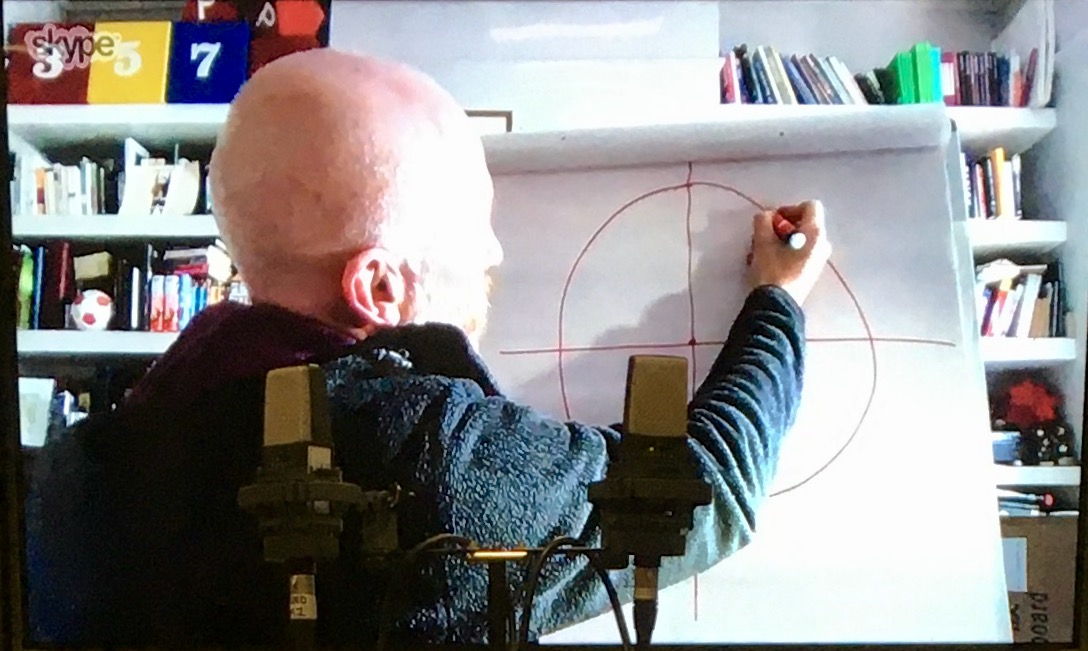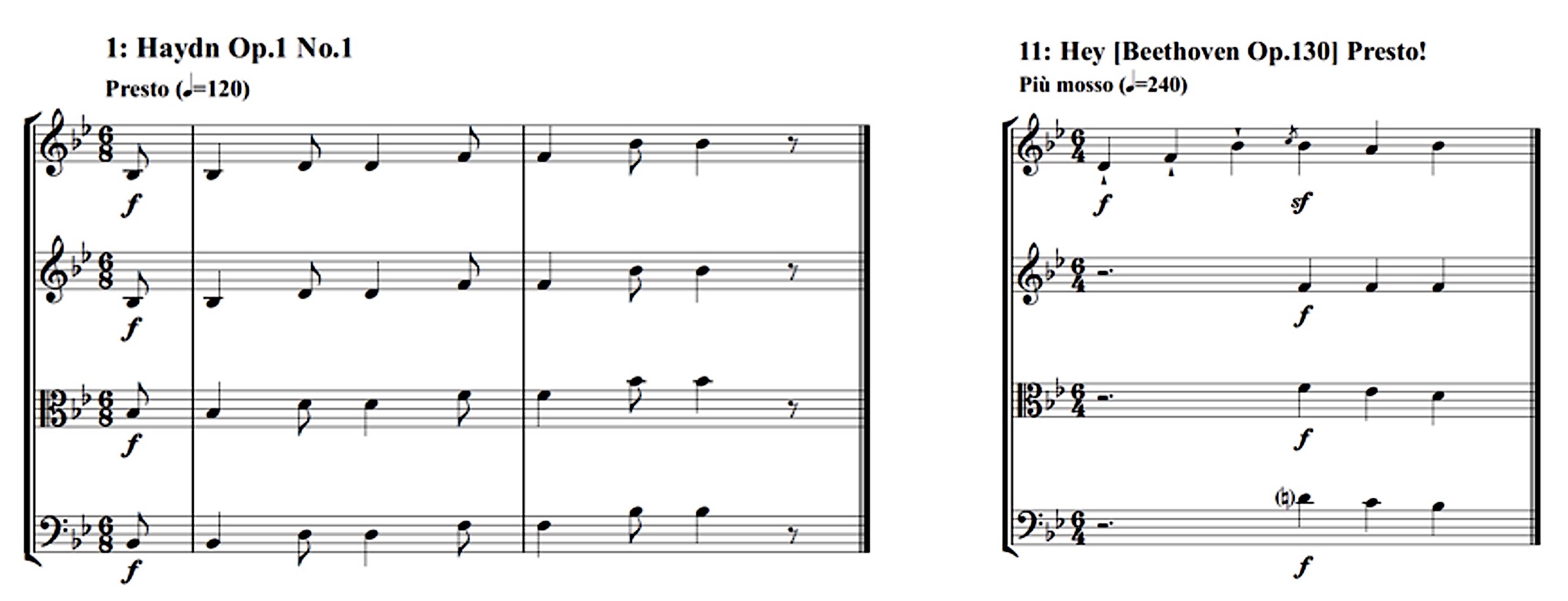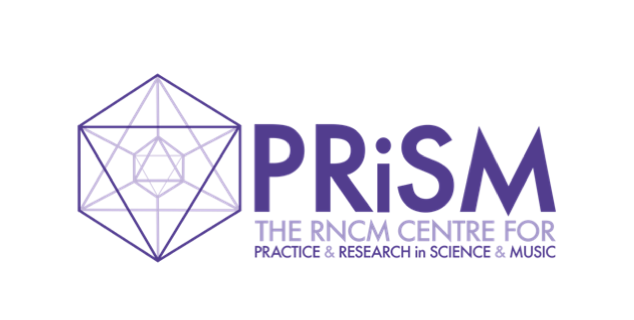music | play | maths
PRiSM Directors composer Emily Howard and mathematician Marcus du Sautoy lead students in a day of mathematical-musical exploration at the RNCM
26 June 2020
On 11 March 2020, PRiSM Directors composer Emily Howard and mathematician Marcus du Sautoy led music | play | maths, a day of mathematical-musical exploration at the RNCM connecting GCSE/A-level maths and music students and teachers from Manchester-based schools with RNCM student composers and performers. It was a first opportunity to share PRiSM’s interdisciplinary spirit through the RNCM’s well-established Learning and Participation programme, made possible by PRiSM’s Research England Expanding Excellence in England funding.

Marcus du Sautoy joined Emily Howard, using RNCM Ensemble+, to lead music | play | maths
Geometric Proofs
The day began with Marcus and Emily discussing some of their own developing working methods.
Marcus: To be a mathematician is to be a composer of proofs. A proof is a journey from the axioms and established truths of the past to the new revelations of the future. It was Euclid’s great work The Elements that introduced the power of proof as a means to access the eternal truths about numbers and geometry. The axioms are where it all begins: the self-evident truths of mathematics from which we begin our logical saga. The proof is the logical moves that we can make from those axioms. Already in Euclid we find some of the classic archetypes of proofs used by mathematicians down the ages.

Marcus du Sautoy demonstrating the construction of geometric shapes.
Marcus: The Elements is full of geometric proofs that show how by combining simple geometric steps you can construct complex mathematical shapes. Each proof shows how by combining a sequence of drawing straight lines or arcs of circles you can gradually build such complex shapes as a pentagon or a hexagon.
Marcus’s drawing inspired the school groups to construct geometric shapes in their own work during the afternoon.

A group of school teachers and students developing ideas for their own composition with RNCM students.
The Music of Proof
Four Musical Proofs and a Conjecture is a collection of miniatures for string quartet: five short movements, each associated with a different mathematical idea, each a poetic translation of a mathematical idea into sound. The work arose through the PRiSM collaboration The Music of Proof, an exploration of different forms of mathematical proof through the creation of music.
Emily: I created a set of five miniatures for string quartet Four Musical Proofs and a Conjecture by considering the question “What if I approach writing music as though I am proceeding with the construction of a mathematical proof?”. I therefore made it a mission to make logical compositional decisions wherever possible, and this new way of working has enabled me to find new creative insights. Throughout the piece, I have used direct quotations from string quartets by Haydn, Beethoven and Schubert, as a way to provide clear arrival and departure points in the music.
RNCM students Emily Blaney (violin), Weiling Thong (violin), Mateus Dandalo (viola) and Nikolaos Maridis (‘cello) formed a string quartet to perform the second miniature from Four Musical Proofs ‘Geometric Proof’ for the group.

Emily Howard with the RNCM student quartet
Emily: So how did I approach Geometric Proof musically? Shape is important within geometric proof, and so this made me think about taking two very short musical fragments and concerning myself with their musical shapes. After a conversation with members of the Piatti String Quartet (who gave the first performance of this work at New Scientist Live in 2017) about works from the string quartet repertoire that they love to play, I chose a fragment from Haydn Op.1 No.1 and another from Beethoven’s Op.130. And I asked myself “How can I get from a fragment of Haydn to a fragment of Beethoven by changing the shape of the musical fragment systematically using discrete steps?”
Emily uses 11 discrete ‘shape changes’ to move between 1 (Haydn) and 11 (Beethoven) in ‘Geometric Proof’ (see extract below) and it is these 11 steps played in succession that form the movement.

Extract from Emily Howard Four Musical Proofs and a Conjecture. Edition Peters No. 73344 © 2019 by Peters Edition Limited, London.
The performance of ‘Geometric Proof’ stimulated a group discussion about how varied the journeys of mathematical (as well as musical) proof often are. The students were then asked to think about how they might transform a musical fragment as a way to develop their new piece of music.
The Creative Process

Groups of RNCM and school students and teachers developing their musical ideas together.
The members of the RNCM student quartet joined RNCM composition students Jose Del Avellanal Carreno and Lavender Rodriguez, and RNCM performance students Martha Cullen, Lorna Day, Clare Hood, Billie McCaffrey and Jemima Gray to work with the school groups, and help them to develop their ideas into a new piece of music.
Performances
Each of the four groups performed and explained their ideas to the rest of the students, Emily and Marcus.

The four student groups share their performances.

The groups also shared and explained their scores.
The speed with which each group grasped the concept and starting playing with the ideas was staggering. It needed very little help from us to guide them towards a rich vein of ideas. The school kids together with performers from the RNCM very quickly translated the mathematics they came up with into a very interesting range of soundscapes. Marcus du Sautoy, Simonyi Professor for the Public Understanding of Science and Professor of Mathematics, University of Oxford, Co-Director PRiSM
We would like to thank staff and pupils from the following schools for taking part in music | play | maths:
- Cardinal Langley School
- Essa Foundation Academy Trust
- The King’s School Macclesfield
- Sharples School
- Shevington High School
- St Gabriel’s RC High School
- Thornleigh Salesian College
- Whalley Range High School for Girls
- Wigan and Leigh College
A huge thanks to you and your team for hosting the event today. I can honestly say it was amazing and one of the most unique events we have been too. The students loved it, and have said it will definitely influence their future musical compositions. Mark Irwin, Music Lecturer, Wigan and Leigh College
This has been a wonderful opportunity for PRiSM to work closely with the RNCM’s brilliant Learning and Participation Team and we are so grateful to Fiona Stuart for the massive amount of energy and time she put in to organising this event and making sure everything ran so smoothly. We look forward to further ventures. Emily Howard, Director PRiSM
In the week of music | play | maths, we were on the cusp of the UK’s coronavirus lockdown, and Marcus du Sautoy was unable to be with us in person at the RNCM. We were lucky that at very short notice music | play | maths was able to go ahead, as Marcus was able to join us from his home in London facilitated by equipment made available by RNCM Ensemble+, an initiative designed to create a network of higher education and professional partnerships with a focus on remote communication. In retrospect, given the past few months, it is now interesting to read Marcus’s reflections on this:
Marcus: The ability for me to communicate via video worked remarkably well and a lot of credit should go to the team at RNCM for making this work. Although I wasn’t able to attend in person, the video set-up gave me a real sense of being in the room with the students. I was able to hold one-to-one conversations with students who wanted to discuss ideas, together with being able to comment more widely on the workshop. The several second delay between my speaking and being heard in the room was a slight handicap to being totally present but I think we managed it pretty well.


